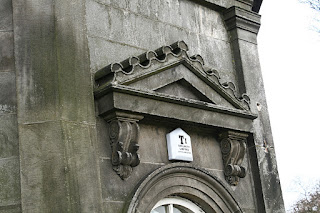Now a sewing shop, St John's well stands isolated on the A661 Wetherby
Road. IT is in an area of parkland called the Stray. It is also very
close to another memorial I photographed some time ago.
This particular well was
named after a church, later replaced by Christ's Church in Church
Square.
 |
St John's Well plaque,
Inscription below |
THIS CHALYBEATE SPRING, WAS ORIGINALLY KNOWN AS THE SWEET SPA, WAS DISCOVERED BY DR. M.STANHOPE, WHO DESCRIBED IT IN HIS "
CURES WITHOUT CARE" OF 1632. a STONE COVERING WAS PROVIDED IN 1656. THE FIRST PUMP ROOM BEING BUILT IN 1786 BY LORD LOUGHBOROUGH. THE PRESENT BUILDING WAS ERECTED BY THE IMPROVEMENT COMMISSIONERS IN 1842 TO A DESIGN BY I.T.SHUTT, ARCHITECT OF THE ROYAL PUMP ROOM.
For a description of chalybeate go
here. I had never heard of this word 'til now!
Thre is a reseach document on spring water
here.
 |
| The arch over the front door, compete with burgular alarm! |
 |
| View from the rear - The plaque is just visible |
 |
| The other rear view. The building has 8 sides. |
 |
This is clearly a drinking trough. There is a waste pipe running towards the ground.
The vertical slot looks like it may have had a lever attached at some point. |
 |
| The main Wetherby Road - Wethereby is to the right. The photo is from the Stray. |
|
|
Below is an excerpt from the history of Christ Church a few hundred metres from St Johns Well. The link to the website is
here.
The real story of the worshipping Christian community in Harrogate begins in 1749
when a Chapel of St John was built so that those who had come to take
the waters of the developing spa town had a place in which to say their
prayers. It was a small building capable of seating about 100 people and
was a chapel-of-ease to the mother church of St John the Baptist at
Knaresborough. This was the first Christian community established in
Harrogate and - other than the chantry chapel - the first church
building to be built in the town. This also demonstrates an often
forgotten feature of the Church of England in the 18th century: it is a
century often described as a time of little zeal in church life, but the
Rector of Knaresborough, like many of his contemporaries, shows genuine
missionary instincts in planting a new church in this growing partof
his parish.
The new church building was known as St John's Chapel because of its links with its mother church at Knaresborough, but it was dedicated on 17 June 1749 as Christ Church. The links with Knaresborough remained until 1852
when Christ Church became a parish in its own right, and the patronage
(i.e. the right of appointing the vicar) passed from the Rector of
Knaresborough to the Bishop of Ripon. As Harrogate grew and prospered
over the next 150 years four further parishes were formed from Christ
Church, High Harrogate: St John's Bilton in 1858, St Peter's in the town
centre in 1870, St Luke's in 1898, and St Andrew's Starbeck in 1911





